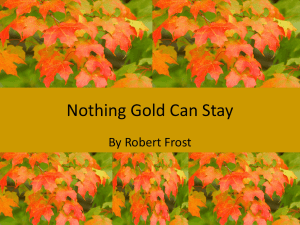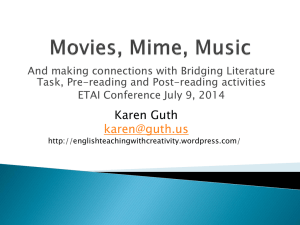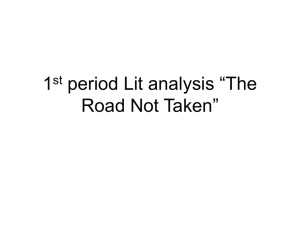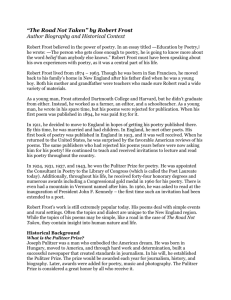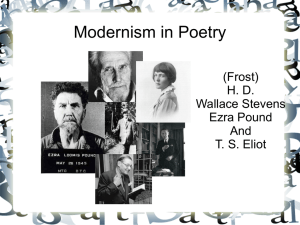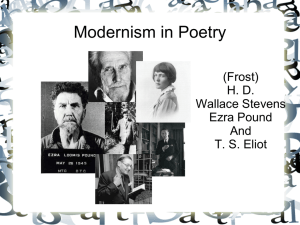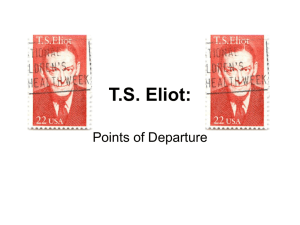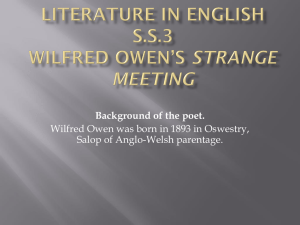Writing in English 1102
advertisement
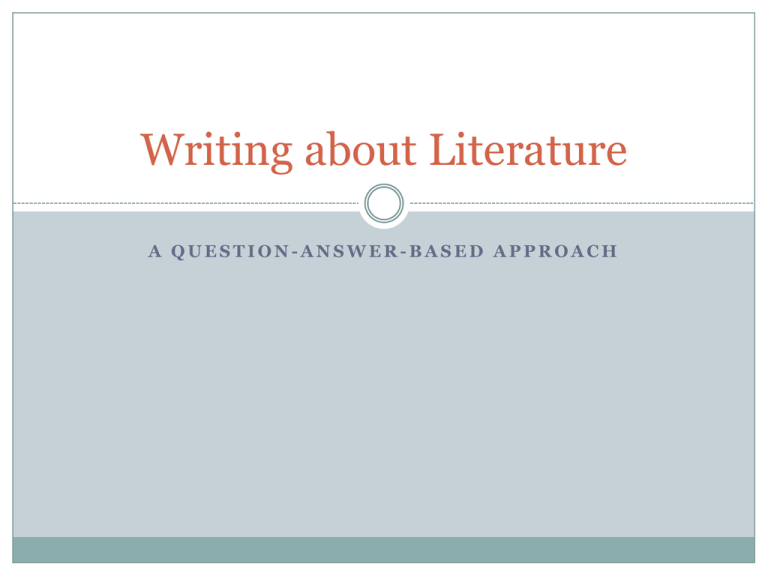
Writing about Literature A QUESTION-ANSWER-BASED APPROACH Basic Essay Structure Title (must have an engaging one!) Introduction Rhetorical hook (interesting piece of information, statistics, fact) Bridge (background information on the topic) Thesis statement (the central ARGUMENT of the paper) Body paragraph Topic sentence (states the content of the paragraph) Supporting details (facts, statistics, expert opinion, personal experience—if relevant) Transitional sentence (to close this paragraph and transition into the next one. Conclusion Restate thesis Summarize key findings/observations/opinions Closing remark. A Good Introduction Frost: The Legacy of an American Poet Robert Lee Frost was an American poet, arguably the most recognized of the twentieth century. “Frost came of age during a time when Modernism was the dominant movement in American and European literature. Yet, distinct from his contemporaries, Frost was a staunchly un-modern poet” (“Frost, Robert”). “Modernist poetry largely abandoned conventional poetic forms as obsolete. Nevertheless, Frost powerfully demonstrated that traditional poetic forms were not obsolete by combining a clearly modern sensibility with traditional poetic structures. Accordingly, Frost has had as much or even more influence on present-day poetry—which has seen a resurgence in formalism—than many poets in his own time” (“Frost, Robert”). However, Frost’s enduring legacy goes beyond his strictly literary contribution: He gave voice to American virtues (Student Paper). A Good Body Paragraph What is it about Frosts’ writing that draws his audiences’ attention? What about his lyric is worthy of poetic dissection? Perhaps the answer lies in Frosts’ ability to pluck an emotional chord in his readers with his use of metaphors, or perhaps his ability to extend pen to paper and create a world of beauty or of nightmarish pain. Frost’s personal life was a constant struggle with depression, mental illness and death, losing his wife and four of his six children. In his poem “Home Burial,” the father of the dead child speaks words that could have been Frost’s: “I shall laugh the worst laugh I ever laughed./ I’m cursed. God, if I don’t believe I’m cursed” (Frost). Despite sometimes daunting images, Frost was also a master of creating beautiful images in his poetry. A Good Conclusion Readers respond readily to Frosts’ poetry because it is sonorous and presents a meaning, a moral. His poetry is not simple, nor does it oversimplify the problems of the twentieth century and beyond. Frosts’ work speaks of despair, of endurance, of failure and success—of life as any man or woman has witnessed. And it is accessible (Thompson). Frosts’ work plays by poetic rules that readers recognize; it often has rhyme, rhythm, stanza organization that reinforces meaning, and key symbols that express more than the literal sense of the poem. It is art that readers can meditate on (Thompson). The literary genius of Robert Frost has become a permanent part of America’s literary heritage (“Robert Frost Collection”). A Few Good Thesis Statements With the help of postcolonial criticism, Native American literary pieces and their messages can be evaluated in order to enrich the canon. Charles Dickens’ “A Christmas Carol” and Joseph Conrad’s “Heart of Darkness” exemplify the opposing feelings of hope and despair. The combination of this newly-found interest and elevated sense of need for innovation and Freud’s other discoveries and theories, such as the existence of the unconscious, defenses, and the meaning of sexuality and death are elements that enrich numerous Modernist literary pieces, including F. Scott Fitzgerald’s The Great Gatsby. Elements, such as the character of the private detective, the character of the female protagonist, and use of mise-en-scene exemplify the similarities and differences between the two movies. (This thesis was written for a paper that discussed film noir movies.) The novel concerns itself very much, albeit perhaps unintentionally, with such issues as materialism, class struggle, and classism, consumerism as they all relate to the given social structure, history, and culture of nineteenth-century France. Their well rounded characters must serve many purposes, but one perhaps above others is to provide readers with a glimpse into the characters’ purpose in life as Eliot poses the important question, “Why have I been born,” in the fashion of Eliot’s own beliefs and those of the Biblical Job. Literary Analysis “To analyze” means “to examine something in detail to determine its nature or tendencies” (Annas and Rosen 20). “An analysis of a literary work usually focuses on some particular aspect of the work that will illuminate for your reader the work as a whole” (Annas and Rosen 20). “What you choose to analyze needs to be limited enough that you can fully explore it and significant enough that your analysis will advance our understanding of the poem, story, play…” (Annas and Rosen 20). You might want to approach aspects of themes, characters, settings, plot structures, and tones of a particular work, for example. (The list of possibilities is absolutely endless!) Literary Explication “In an explication, you go through the work line by line or sentence by sentence, sometimes word by word, unpacking the meanings of the text piece by piece” (Annas and Rosen 20) “In explications, details are crucial and so is the relation of each detail to other details and to the work as a whole” (Annas and Rosen 20). A good explication comes from the extremely close reading of a piece of work. Explications are often much longer than the piece itself, so choose a short poem to explicate. Consider ALL aspects General Guiding Questions for Analysis/Explication: What is happening in the poem? What are words that can have important secondary meanings? Is there a persona/speaker/character(s)? Who? What is he/she/they like? What gives away their character traits? What is the setting, both physical and historical? What is the relationship between the speaker/narrator/characters and their world? Is there conflict? What kind(s)? What images, based on our five senses, are in the work? Are their more images or just one expanded image? Question continued What are the sounds of the poem? Are their any rhymes, rhythms, or repetitions of words, vowels or consonants? What is the stanza structure? Why are the lines broken where they are? What does it mean for the entire poem’s mood or meaning? How does the title comment on or extent the work? What are the significance of the beginning and ending of the work? What is the mood or tone? What creates it? Question continued (2) What does the poem mean? If you are writing a research paper, try to place this work in relation to other works by the same and/or different authors, written in the same or different historical/literary period/place. A comparison based on the above can make a good research paper! After answering all these question informally, you are likely now understand the piece of work very well and are ready to put your thoughts in the paper. Common Analysis-related Pitfalls You are not familiar enough with the work(s) and/or author(s) you are trying to discuss. You simply summarize the story or poem and add little or no analysis. You simply copy the lines of a poem and neglect to analyze/explicate their content. You do not support your opinions/ideas with quotes from the text. You include too many quotes and drawn out your own thoughts. You do not clearly connect quotes to your own statements. Your paper lacks a central focus (idea, thesis, argument). You do not write about what is asked of you. The thesis does not reflect the actual content of the paper. Common Writing-related Pitfalls Your work falls short of the length requirements. Your paper in part or in whole is plagiarized. In-text citations are missing and/or incorrect. Works Cited page entries are missing and/or incorrect. Paragraphs are too short and/or disorganized. The paper contains grammar, punctuation, spelling, capitalization, and style mistakes. You use “you” and “I/we” (the last one is fine once or twice). You use slang, clichés, and euphemisms. The tone of your paper is informal and does not suit the academic nature of the assignment. Reviewing the Basics Is my title engaging? Does the introduction contain essential information (author’s name, work, topic, etc)? Does the paper have a thesis (a point)? Do I support my argument with sufficient persuasive details? Have I recognized possible objections to my thesis, and have I offered adequate counterarguments? Is the paper well organized and clear to the reader? Have I argued my point effectively without talking too much about myself? Does the essay fulfill the assignment (length, scope)? (Barnet, Cain, and Burto 338). Is the paper formatted according to MLA rules? Do I cite all borrowed material, and are all my citations formatted according to MLA rules? Did I turn to my instructor when I needed help?
